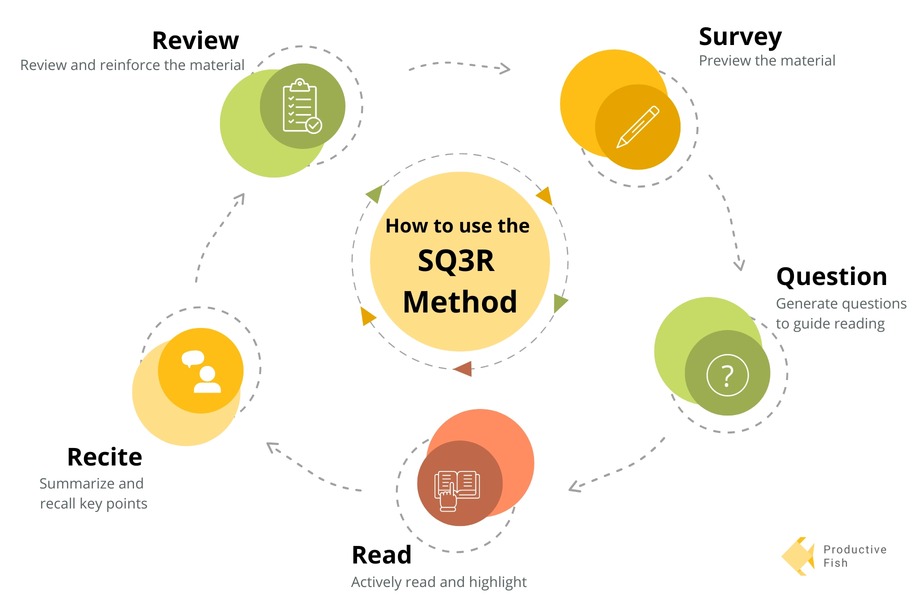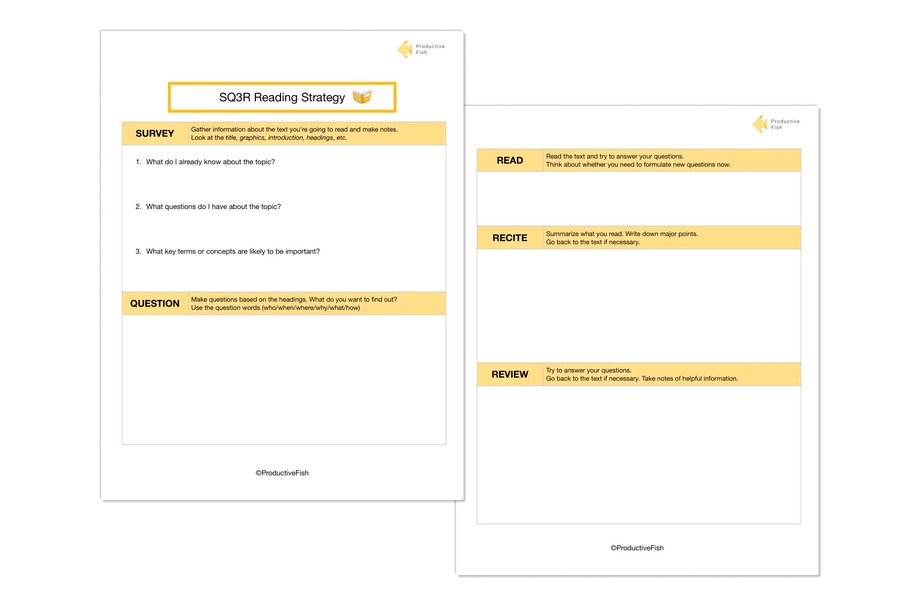SQ3R Reading Strategy and How to Apply It
Updated on 05 Jan 2024 • 5 min read • posted by Maria H
How many times have you read an entire chapter of a book, only to realize afterward that you don’t remember any of what you just read?
If that happens to you frequently, this article is for you!

Preparing for exams or tests can be stressful. Indeed, having to memorize a whole lot of information, sometimes from complex textbooks, in a short period can be daunting.
However, nothing is impossible!
And fortunately for you, there is an easy way to better remember what you read and improve your overall performance at school. Do we have your attention?
In this post, we’ll tell you everything you need to know about the SQ3R reading strategy so that you can score amazing grades in all your classes ;)
What is the SQ3R Method
In 1946, Francis P. Robinson, an American education philosopher, introduced the SQ3R in a book called Effective Study.
SQ3R stands for:
- Survey
- Question
- Read
- Recite
- Review
It was designed for college students, but it’s now widely used by schools worldwide to help students learn more effectively.
This method emphasizes active reading. The idea is for students to start by surveying a text before answering questions as they read it. By doing so, their brain is actively engaged in the process, allowing them to significantly improve their comprehension of the text. The next step sees students writing down their answers and reciting them. This enables the concepts and ideas to sink in and commit to their long-term memory so that they can recall them later.
Key Benefits of the SQ3R Method
The SQ3R study method has been proven to provide many benefits to students. The main features of SQ3R are:
Optimizing Studying Time
It may seem it’ll take more time to read using the SQ3R method, however, it’s actually one of the best ways to optimize your studying time.
By answering the questions in your own words, the method allows you to facilitate the transfer of new material to your long-term memory, thus increasing your ability to retain the information you’ve just read.
Since the information will now be committed to your long-term memory, you’ll be able to remember it better for your test and won’t need to read it over and over again. Besides, as you develop a structured way to read, your learning and reading speed will greatly improve, saving you time down the road.
Enhancing Concentration
Information overload can significantly affect your concentration, preventing you from studying efficiently. The good news is that utilizing the SQ3R study method can help. As you only select the relevant information to answer specific questions, you’ll, in fact, automatically stave off information overload.
Indeed, through the question, read and recite stages, you’ll have to concentrate on the information you’ve read and the task at hand.
And here is how it works:
- Generating questions during the question phase helps you enter the right mindset to absorb, understand and retain information.
- Reading with a specific purpose in mind will help you stay focused on the material, training your brain to concentrate and preventing it from wandering off.
- Reciting requires concentrating as you select the relevant information and say it out loud.
This will focus your attention on the subject and help improve your concentration.
Improving Comprehension and Memory Retention
Research shows that the SQ3R method is extremely efficient in improving comprehension and memory retention.
As a matter of fact, reading with intention enables you to maximize your understanding of a text. By focusing on the most relevant information, you’ll also be able to remember the content better. And as you actively review your understanding throughout your reading, your comprehension and memory retention will continuously improve.
Note that the preparation you’ll accomplish during the survey and question phases is critical in improving your comprehension and memory retention. Indeed, these phases help activate your thinking. And as you activate your thinking and skim over important parts of the text, you’ll prepare your brain to absorb information. This means your brain will be ready for what is to come, thus understanding and storing information more efficiently.
How to Use the SQ3R Method
By now, you must be wondering how to apply this incredible method to your studies. Here are the five steps you need to follow to read and study more efficiently with SQ3R.

Survey
The idea during the survey phase is to skim over the text for the first time (1 to 3 minutes).
During the survey phase, all you need to do is look at the headings, subheadings, bold text, pictures, and charts. You can also read the first paragraph as it usually works as an introduction and will most likely outline what the content is about.
During this step, you’re simply trying to understand what this text, chapter, or piece of content will be discussing. And skimming over visual cues will give you a good indication.
Question
The ‘‘questioning’’ step is one of the most important. Before reading the text, you’ll need to ask yourself a few questions based on your survey.
For instance, let’s say you’re reading a history book to prepare for your next history test. The chapter is about Greek Mythology. And the three subtitles in the chapter are:
- An overview of Greek myths
- Greek gods and religious practices
- The decline of Greek mythology
Some of the questions you could ask yourself include:
- What are Greek myths? Why were they created?
- Who are the Greek gods?
- When did Greek mythology decline, and why?
Write down these questions so you can answer them as you read the content. This step is excellent preparation for reading and should only take 10 to 15 minutes, depending on the text or chapter’s length.
Read
The next step is reading. Ideally, try and break down your reading time into 20 to 30-minute sessions. You should then take a short break and repeat.
While reading, keep the questions you’ll have to answer after reading in mind. This way, your brain will select the relevant information as you read and get ready for the ‘’recite’’ phase.
During this step, you should also make sure that you’re reading in a quiet and comfortable environment. As a result, turn off any distractions such as your laptop or your phone.
Recite
Now that you’ve read the text recite out loud the answers to your questions. Reciting out loud can significantly help you process the information you’ve just read and make better sense of it.
Reciting is a critical phase because, during this step, the information you’ve just read and learned will be transferred from your short-term memory to your long-term memory.
Review
Pull out the questions you originally wrote down and try to answer them.
Note that the review process should happen at the end of reciting and ideally be repeated over time. This is the only way the information stored in your short-term memory will commit to your long-term memory.
SQ3R Template
To make things easier, we created the SQ3R method template so you can get started right away. You'll find all the steps neatly organized in one place with editable text fields. Plus, you can even print out the template to make handouts.
For your notes in Microsoft Word or Google Docs use these SQ3R template.
For your convenience, we've also prepared the PDF version of our SQ3R method template.

And if you want to try more note-taking methods, check out our collection of templates for note-taking.
Understand Better What You Read
By following the steps above, you’ll be able to quickly and efficiently understand and retain relevant information from dense textbooks or any other reading material. The SQ3R method is a powerful tool that can help you nail your tests, and we hope you’ll give it a try and let us know how you go ;)
Have you ever tried the SQ3R reading comprehension method before? If that’s the case, we’d also love to hear all about your experience in the comment section below!